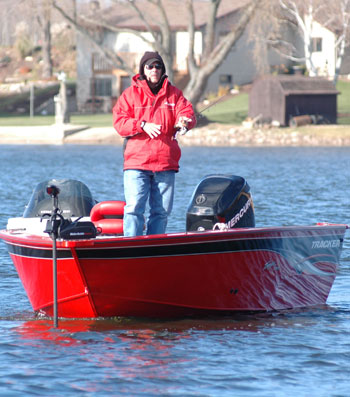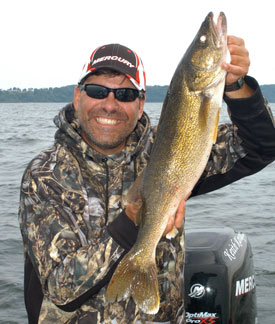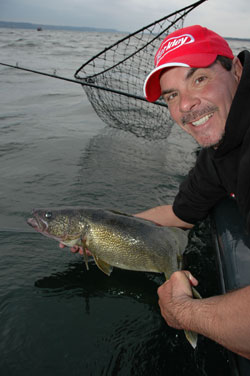Why do you think so many walleye anglers proclaim fall as their favorite time of year to fish? It could be because the cooler season is known to produce catches of big fish, or it may simply be because the completion for prime water is at a yearly low with fewer fishermen on the water. For us, the reason is that fall offers just so many options! Rivers, reservoirs, natural lakes; jigging, rigging, trolling; so many ways to catch walleyes in the fall, with every body of water offering its own unique opportunities. Here’s a rundown of a few of our favorite patterns for this time of the season.
 Rivers:
Rivers:
It seems that most walleye fishermen begin their spring season fishing rivers; the walleyes are there to spawn and the bite is predictable. But the fish don’t just show up in the rivers right before spring … they actually begin that migration in the fall, and they come in hungry and ready to chow down in preparation for a long winter. The biggest advantages to fishing rivers in the fall is that most of the anglers that were fishing these spots in the spring are now either hunting or at home watching football, and the river is teaming with hungry, aggressive fish that you can often have virtually to yourself.
The fish are moving into the river but not setting up in any one place. They’re on the prowl, feeding and then moving on. Concentrate on intercepting these fish in spots where their route offers good feeding opportunities. Channel edges are key, especially where they offer the walleyes feeding stations and holding areas. Deltas formed by incoming creeks and wing dams are always going to attract fish. Outside bends in the channel create wash-outs and eddies that can also be good areas to look for fall walleyes.
Normally on the river this time of year you’re dealing with light current and fishing moderate depths with ten to twenty feet being the average. Vertical jigging is an excellent way to target these fish with jig selection in the 1/8 to 3/8 ounce range being the norm. Jigging action can be a bit more aggressive than you used in the spring, but it often makes a big difference in the number of bites you’ll get if you get in the habit of leaving your jig rest on the bottom a little longer than you normally do. Experience has taught us that walleyes in these situations like to suck the bait off the bottom. Opting for a semi-stand-up style jig, like the Bass Pro Shops XPS Walleye Angler Jig or the Fin-tech Nuckle Ball Jig, will position the bait angling slightly off bottom, making it an easy target.
Walleyes tend to be big eaters in the fall, so it helps if you offer up a big bait. Bulking up your jig, either by using larger-than-average sized minnows (four to five inchers are good), or by adding a plastic body such as a three inch Berkley Power Grub or a four inch GULP! Minnow Grub, will add the size and attraction to get these fall walleyes’ attention.
 Reservoirs:
Reservoirs:
When it comes to fall walleyes in reservoirs, sharp breaking structure seems to be the ticket for holding the most fish. Not unlike what we discussed in regards to rivers, the old river channel can play a key role in reservoirs too. Good spots to start the search would be where the old river channel contacts main lake points, or where large main lake flats drop sharply into deeper water.
On smaller, more isolated spots such as inside turns of points or “cups” where fish are tightly grouped, a presentation like a bottom bouncer live bait rig dressed with a large minnow or Creek Chub is tough to beat. This rigging will allow you to move along a point break covering water until you contact fish or spot them on your electronics. Then you can hover over the fish putting the bait right on their noses. Because you are using a larger minnow, a quality wide-gapped hook like Mustad’s Double Wide Beak Bait Hook (model # 10548R) in a size 2 to 1/0 (to match the bait size) is essential for successful hook-ups. It’s a deadly tactic that has accounted for many a trophy reservoir walleye over the years.
In situations where the fish are scattered up and down long stretches of structure like the deep edge of a large main lake flat, few techniques get the job done better than contour trolling with lead core line. The key to contour trolling is to keep the bait near the bottom. That can be tough when you’re trying to cover multiple depths in a trolling pass to contact the walleyes scattered along the break. What makes lead core so effective for this type of contour trolling is that it is very “speed affected”. Because of the line’s bulk, water resistance effects how it runs in the water, so if you increase your trolling speed, the lead core gets pushed up and runs shallower. On the other hand, if you slow down, the weight of the lead core enables it to drop down and run deeper.
 Natural Lakes:
Natural Lakes:
While many walleye anglers struggle to put together consistent walleye catches on natural lakes in the summer months, fall can be a time of plenty. This may be your best chance at catching the biggest walleyes these waters have to offer. Very similar to fishing reservoirs, structures offering access to deep water are primary targets. Main lake points that extend into the lake basin, and humps or sunken islands surrounded by deep water are key structures, especially if they feature rocks and scattered weeds.
Again, big minnow fished on slip sinker live bait rigs or bottom bouncer bait rigs worked slowly up and down the breaks will catch not only walleyes, but often several “bonus” species such as small mouth bass and northern like where present. Another deadly tactic on these structures is jig trolling. With jig trolling, the object is to cover relatively small areas efficiently and with finesse. Moving along structure with the bowmount electric motor and keeping the jig at about a 45° angle to the rod tip, impart a simple “lift-pause-drop” action to the jig as you move along. This will keep the bait in the strike zone while maintaining good feel of the bottom.
Summary:
Autumn is a time of year many anglers put away the rods and reels to follow other pursuits like hunting, watching football and raking leaves. But for those willing to brave the blustery breezes and nip in the air that fall brings, the reward can be some of the finest walleye fishing you’ll experience all season. Your toughest decision will be where to fish … because whether you hit the river or head to the lake, the bite should be well worth the trip.










